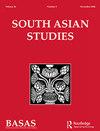Resituating Mughal Architecture in the Persianate World: New Investigations and Analyses
IF 0.7
0 ASIAN STUDIES
引用次数: 0
Abstract
This Editorial Essay introduces the importance and need for the research collected in this Special Issue. Beginning with a definition of ‘Persianate’, the space that the Mughals occupied within this geo-cultural sphere is discussed. As an integral part of not only the existing early modern-era Persianate world, but as inheritors of its cultural memory, the Mughals had an invested stake in projecting this aspect of their heritage. Architecture was one of the means through which they did this. Moving away from the normative classification of the Mughals as being a ‘South Asian’ entity, the exploration of new avenues of research in Mughal-Persianate architectural connections in Resituating Mughal Architecture in the Persianate World: New Investigations and Analyses is introduced. It is seen that the studies in this volume include research on relationships between Persian philosophy and Mughal built spaces; between the architecture and architectural decoration of the Mughals and the Safavids; and on the role poetry can play in evoking cultural memory through architectural representations. Focusing on specific topics that exemplify the shared cultural heritage of the Mughals within the Persianate world, this volume highlights that avenues for studying this topic are ongoing, still necessary and extremely viable.波斯世界中再现莫卧儿建筑:新的调查与分析
这篇社论文章介绍了在这个特刊收集的研究的重要性和必要性。从“波斯”的定义开始,讨论了莫卧儿在这一地缘文化领域所占据的空间。作为现存的早期现代波斯世界不可分割的一部分,而且作为其文化记忆的继承者,莫卧儿人在展示其遗产的这方面有着投资利益。建筑是他们实现这一目标的手段之一。从莫卧儿作为一个“南亚”实体的规范分类出发,在波斯世界重新定位莫卧儿建筑中探索莫卧儿-波斯建筑联系的新研究途径:新的调查和分析。可以看出,本卷的研究包括对波斯哲学与莫卧儿王朝建筑空间之间关系的研究;莫卧儿王朝和萨法维王朝的建筑和建筑装饰;以及诗歌在通过建筑表现唤起文化记忆中所扮演的角色。本卷着重于具体的主题,体现了波斯世界内莫卧儿王朝的共同文化遗产,强调了研究这一主题的途径是正在进行的,仍然是必要的和极其可行的。
本文章由计算机程序翻译,如有差异,请以英文原文为准。
求助全文
约1分钟内获得全文
求助全文

 求助内容:
求助内容: 应助结果提醒方式:
应助结果提醒方式:


